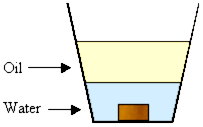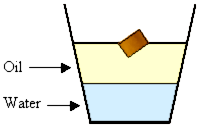Where will the wood float?


- how your observations give evidence for your first explanation or
- how your ideas have changed because of your observations.
Equipment:
A clear container containing 1/2 water and 1/2 oil; a block of wood of regular shape that will fit in the container.
One way to organise the session:
- Ask the students to complete their prediction and first explanation independently.
- Discuss their predictions and reasons either in a group or as a class.
- Either demonstrate to whole class, or explore in groups, where the wood floats.
- Allow time to focus on and complete observation task.
- Discuss their ideas about what they see.
- Complete the explanation.
- This could lead to further questions the students may want to investigate.
Observation prompt questions
- What do you notice about the oil and the water?
- Is the wood more in the oil or the water?
- How much of the wood is above the oil?
- How much is below?
- describing being about what you see, and explaining being about what your observations make you think.
- that predicting is not guessing, but applying science understandings to a specific context.
| NOTE: The explanations will depend on where the wood floats. Choose the correct observation for your demonstration. | |
|
Observation
|
Explanation
The wood is less dense than the oil (and water).
or
The oil (and water) is/are denser than the wood.
|
 |
The wood is less dense than the water but denser than the oil. or The water is denser than the wood, but the oil is less dense. |
 |
The wood is denser than both the oil and the water. or The oil and the water are less dense than the wood. |
| NOTE:If the piece of wood is floating high in the water or oil, it will seek a more stable position. Instead of lying flat, it may sit as shown in the first example. The shape of the piece of wood will also influence how it sits in the water. | |
A simple definition of density is how heavy something is compared to its volume. Students may have a partial understanding of density; they may talk about the wood being light or heavy. They are less likely to consider the volume of the piece of wood.
a) finding out students' initial ideas;
b) generating discussion;
c) motivating students to want to explore the concept;
d) generating investigations.
Notes on floating and sinking
This resource focuses on density, both of the liquids and of the solid. Density is just one of the factors that affects flotation.
Different woods have different densities. For example, a hard wood is more likely to sink than a light wood. A piece of wood that is left in water becomes waterlogged, which increases its density. Therefore, if the wood is left in the mixture, where it floats may alter. Even within one tree there may be variations in the density of the wood, because trees grow faster in summer, producing less dense wood. Heartwood is generally more dense than the outer wood. Green wood becomes less dense as it dries.
Oil is less dense than water, which is why it floats on top of water. Some wood may be supported by the water, but not by the oil.
You can measure density by dividing the mass of an object by its volume. One cubic centimetre of water weighs one gram, so scientists say water has a density of one. If a solid object has a density greater than one, it will sink in water. The maths involved is likely to be too challenging for most Year 7 and 8 students.
Density however, is only one aspect to consider when predicting if an object will float or sink. Very dense materials can float if the shape is changed so that the object pushes more water out of the way. This is called displacement.
Next steps
Getting students to feel the "heaviness" of a variety of wood types and compare where they float may help them understand the concept of density. Further possible investigations about density:
- Do you get the same results with other types of wood?
- What happens if you have less oil/less water?
- What happens if you use other liquids?
- Does the size of the piece of wood affect the result?
Investigating pieces of wood that are the same size and shape, but of different densities, makes managing the variables easier for students, as they do not have to consider volume. Woods you could use for comparisons are:
- balsa wood, cork, whau (light);
- pine (medium);
- jarrah, matai (heavy).
Once students have thoroughly explored the concept of density, the idea of shape as a factor can be investigated, with an emphasis on the concept of displacement.
Activities can be found in:
- Ministry of Education (2003). Building Science Concepts Book 37, Floating and Sinking, and Book 38, Understanding Buoyancy. Wellington: Learning Media.
- Ministry of Education (1999). Making better sense of the physical world. Wellington: Learning Media (pages 121 and 122).


